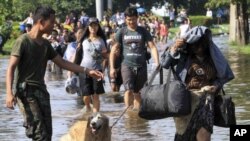The United Nations says ongoing floods in Southeast Asia are triggering a humanitarian crisis.
Floods and disasters in Thailand, Laos, Cambodia, Vietnam and the Philippines have killed more than 700 people and affected eight million others.
The Thai capital remains under threat of flood waters that have already inundated factories considered to be a key part of the country’s economic engine.
Related report by Daniel Schearf
Noeleen Heyzer, executive secretary for the U.N.’s Economic and Social Commission for Asia and the Pacific (UNESCAP) said Tuesday the U.N. is ready to support communities hit by the catastrophic floods. But Jerry Velasquez, a senior regional coordinator with the U.N.’s International Strategy for Disaster Risk Reduction (UNISDR) said that over the long term, countries such as Thailand need a more comprehensive framework to manage disasters, especially floods.
"The main shortcoming right now is that there are about eight institutions centrally that deal with water in Thailand," said Velasquez. "That this is an issue not just for Thailand but most of the countries affected by floods now in the region; there’s no comprehensive framework to deal with water and I think this the main issue."
For Bangkok, a critical 48-hour window
Senior city officials in Bangkok say the next 48 hours are critical for the city, where thousands of volunteers, soldiers and government workers are scrambling to shore up flood defenses.
The death toll in Thailand has reached 315 with flood waters affecting 27 provinces. Weather forecasts indicate more monsoon rains are expected in the coming days.
Economist Somphob Manarungsan says the floods could lead to a sharp fall in Thailand’s economic growth rate over the last quarter, with the economic toll rising to as much as $6 billion.
"Maybe up to two per cent of GDP [gross domestic product] - that is a tentative figure but I think it is maybe a bit higher than that - which means it may cost 200 billion baht," he said. "But we still don’t know exactly about this because we can still see the flood still going on."
Key areas of Thailand’s industrial heartland, including six major industrial estates and parks, have been hit by flood waters despite desperate efforts to hold back the flood tide.
The industries produce major export items such as automobiles, computer hardware, other industrial goods and food processing. They employ up to 500,000 highly-skilled workers.
Is the worse yet to come?
UNISDR’s Velasquez says U.N. disaster analysis raises fears the current flooding in Thailand may be a prelude to even worse flood catastrophes in the future.
"The question in our minds is that we’ve predicted the most catastrophic floods [as a once-in-200-years] event - [and] the catastrophic one is this already," he said, explaining that relief agencies classify the magnitude of natural disasters by the statistical probability that they would occur in a given time frame. "So is this the most catastrophic or are we going to see far worse in the future? And, for me personally, I think the worst is yet to come.”
In neighboring Cambodia, nearly 80,000 families in Prey Veng province alone are reported to be facing food shortages for the next year due to flood-related crop losses.
The flooding there is seen as the worst in over a decade, though the reports say the Cambodian government has yet to declare a national emergency.
The U.N. says the floods and disasters across the region pose a threat to the countries’ achieving their key development goals by 2015.









